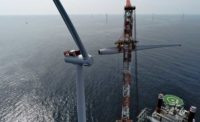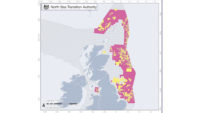

World records for tidal and offshore wind power are likely to be broken in the U.K., because two major energy projects made big advances during February. A 2,400 MW North Sea wind farm secured government approval, while generating equipment suppliers were selected for a 320 MW tidal lagoon in Swansea Bay.
On February 17, the government approved the Dogger Bank Creyke Beck A and B windfarm development off the coast of Yorkshire. To include 400 turbines, the farm will be the world’s largest of its type, according to Tarald Gjerde, general manager of Forewind Ltd, the project developer.
Forewind is a consortium owned by Germany’s RWE, Scotland-based SSE, and the Norwegian companies Statkraft and Statoil.
The project—said to be the U.K.’s largest renewables project to secure planning consent—is divided into two separate 1,200 MW turbine arrays. They will be spread over 500 sq km of the North Sea some 130 km off the coast. Forewind claims to have invested more than $93 million on surveys during the last four years.
Nearly 1,200 offshore turbines, together rated at some 4,000 MW, are now in operation around the British coast, according to the trade association RenewableUK.
Wind power “is vital” to U.K. plans to cut carbon emissions, according Energy and Climate Change Secretary Ed Davey. He values the total investment in wind projects at $22.5 billion since 2010.
Renewables of all kinds accounted for 17.8% of U.K. electricity output in the third quarter of last year, according to government statistics. The official target to produce 15% of all energy from renewables by 2020 implies a contribution to electricity generation of 30%.
Sea-powered generation is still making no commercial contribution to U.K power production, but that could change as developers of the $1.6-billion tidal lagoon scheme in Swansea Bay, off the South Wales coast, are coming close to securing necessary approvals.
The plan involves exploiting the bay’s 8.5-m tidal range by enclosing 11.5 sq km with a 9.5-km-long breakwater wall to contain 16 generator sets.
Work on site would start later this year, assuming the developer Tidal Lagoon (Swansea Bay) plc. secures final approval in summer, says a spokesman. TLSB will be funded by bank loans and equity from the British based financial institution InfraRed Capital Partners and Prudential plc.
In preparation for starting work, TLSB is now assessing bids from civil contractors for the breakwater. Also, the company in February selected U.S.-based GE Power Conversion and Austria’s Andritz Hydro as its preferred bidders for generating equipment worth an estimated $465 million. The two companies will also manage the lagoon plans for five years.





Post a comment to this article
Report Abusive Comment